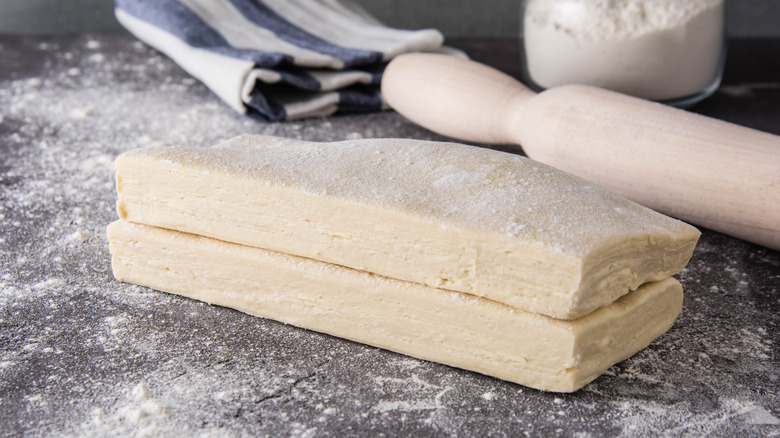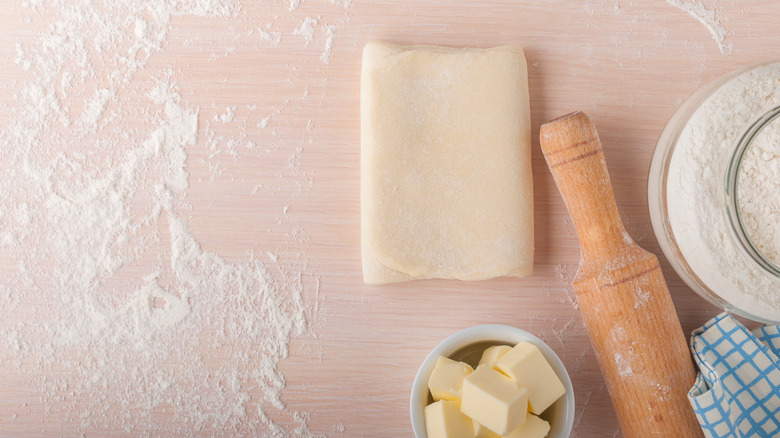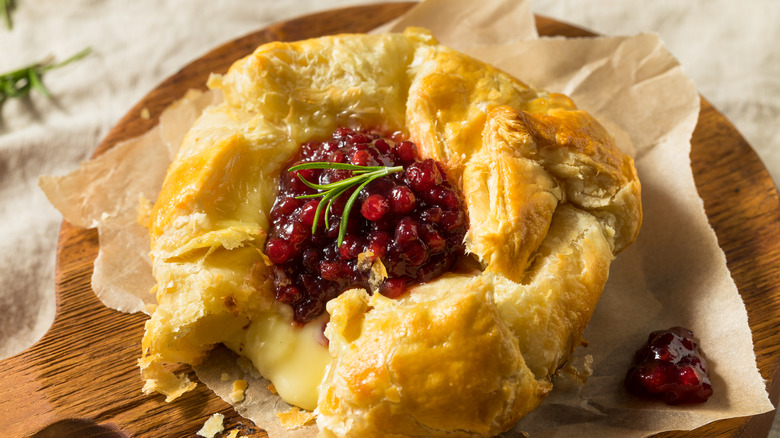The Part Of Puff Pastry Dough You Should Never Roll Out
Puff pastry is one of the most convenient and delicate tools in a pâtissier's arsenal, but far too often, pastries deflate or refuse to rise due to one simple mistake: flattening the edges. Puff pastry, whether store-bought or homemade, is made up of layers of laminated dough, which helps to give the pastry its signature "puff" during baking. Puff pastry rises so dramatically in the oven because butter or fat is in between each layer of dough. When this fat is quickly heated, the water within it evaporates, creating pockets of steam in the dough, and the fat then crisps the dough. But, if the edges of the puff pastry are flattened or crimped, then each layer will have difficulty rising, leading to a flat, sad puff pastry.
The best way to ensure that your rolling pin doesn't overwork the edges of the pastry is to start your rolls from the center. Rather than rolling from the bottom to the top, place the rolling pin over the center of the dough and apply pressure to the middle rather than the handles. Slowly roll it away from you until you nearly reach the edge. Rotate the dough 90 degrees and repeat until the dough is the desired size.
Keep it cool for better results
A good puff pastry must be cooled until it enters a hot oven; you should always keep puff pastry as cold as possible. Butter begins to soften at room temperature. So, when making puff pastry from scratch, it's essential to take breaks while laminating the dough to give the butter time to solidify in the fridge. Some recipes may even call for frozen or semi-frozen butter to extend the time you can work the dough before cooling. It's best to always put the pastry back in the fridge to cool before baking to ensure the fat has fully solidified.
For dishes that involve filling or topping puff pastry, like the ultimate onion tart, ensure that you let the filling cool before adding it to the pastry. Adding hot filling to a cold puff pastry will melt the butter in the dough and add moisture, causing it to become tough and chewy. Similarly, after you're done rolling out the dough, pop it back into the fridge to get nice and cold again.
Other common puff pastry mistakes
Before doing anything with puff pastry, flour your work surface, as it will keep the dough from sticking or warping. If folding the dough or wrapping it around something, such as when making an upside-down tart for extra caramelized toppings, brush off any excess flour, or the areas where the dough's edges are meant to stick will come undone while baking.
When cutting puff pastry into shapes, use a sharp knife and make single, straight-down cuts. Do not cut at an angle or drag the knife across the dough, or the edges will become crimped, just like when rolled. Similarly, if applying an egg wash to puff pastry, make sure that the edges of the dough are left dry, as the moisture will bind the layers and limit puffing.
Sometimes, you'll have leftover corners or edges after cutting puff pastry. Don't throw these away, though, because you can make a whole litany of recipes with frozen puff pastry scraps. They can even be layered together and rolled out to make a larger piece of dough in a pinch.
Luckily, puff pastry dough can be held in the refrigerator for up to three days or in the freezer for up to a month. Just let it thaw entirely before working it, or it could crack or tear.



